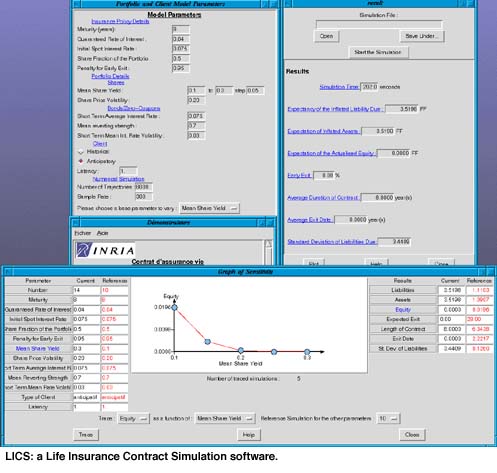Life Insurance Contract Simulations
by Mireille Bossy
A common feature of life insurance contracts is the early exit
option which allows the policy holder to end the contract at any
time before its maturity (with a penalty). Because of this option,
usual methodologies fail to compute the value and the sensibility
of the debt of the Insurance Company towards its customers. Moreover,
it is now commonly admitted that an early exit option is a source
of risk in a volatile interest rates environment. The OMEGA Research
team at INRIA Sophia Antipolis studies risk management strategies
for life insurance contracts which guarantee a minimal rate of
return augmented by a participation to the financial benefits
of the Company.
A preliminary work of OMEGA consisted in studying the dependency
of the Insurance Company’s debt value towards a given customer
on various parameters such as the policy holder criterion of early
exit and the financial parameters of the Company investment portfolio.
Statistics of the value of the debt are obtained owing to a Monte
Carlo method and simulations of the random evolution of the Company’s
financial portfolio, the interest rates and of the behaviour of
a customer.
More precisely, the debt at the exit time t from the contract
(with an initial value of 1), is modeled by D(t) = p(t)[exp(r t) + max(0, A(t) - exp(r t))]. Here, r is the minimal rate of return guaranteed by the contract and
exp(r t) stands for the guaranteed minimal value of the contract at time
t. A(t) is the value of the assets of the Company invested in a financial
portfolio. A simplified model is A(t) = a S_t + b Z(t), where S(t) (respectively Z(t)) is the value of the stocks (respectively of the bonds) held by
the Company; a and b denote the proportions of the investments
in stocks and in bonds respectively. Finally, the function p(t) describes the penalty applied to the policy holder in the case
of an anticipated exit of the contract. Two kinds of exit criterions
are studied: the ‘historical’ customer chooses his exit time by
computing mean rates of return on the basis of the past of the
contract; the ‘anticipative’ customer applies a more complex rule
which takes the conditional expected returns of the contract into
account. In both cases, a latency parameter is introduced to represent
the customer’s rationality with respect to his exit criterion.
(The simulation of a large number of independent paths of the
processes S and Z permits to compute the different values of assets and liabilities
in terms of the parameters of the market, a, b, and the strategy
followed by the policy holder.)
In our first simulations, the asset of the Company was extremely
simplified: S(t) is the market price of a unique share (described by the Black
and Scholes paradigm) and Z(t) is the market price of a unique zero-coupon bond (derived from
the Vasicek model). Even in this framework, the computational
cost is high and we take advantage of the Monte Carlo procedure
to propose a software (named LICS) which attempts to demonstrate
the advantage of parallel computing in this field. This software
was achieved within the FINANCE activity of the ProHPC TTN of
HPCN.
The computational cost corresponding to more realistic models
can become huge. Starting in March 99, the AMAZONE project is
a part of the G.I.E. Dyade (BULL/INRIA). Its aim is to implement
LICS on the NEC SX-4/16 Vector/Parallel Supercomputer. This version
will include a large diversification of the financial portfolio
(around thousand lines) and an aggregation of a large number of
contracts mixing customers’ behaviors.

In parallel to this the OMEGA team studies the problem of the
optimal portfolio allocation in the context of simplified models
for life insurance contract. For more information, see:
http://www-sop.inria.fr/omega/finance/demonst.html
http://www.dyade.fr
Please contact:
Mireille Bossy - INRIA
Tel: +33 4 92 38 79 82
E-mail: Mireille.Bossy@sophia.inria.fr
